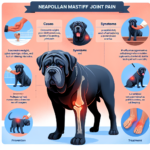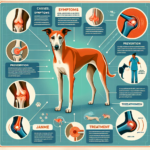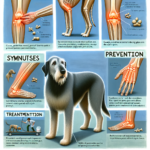Neapolitan Mastiff Joint Pain: Causes, Symptoms, Prevention, and Treatment

Introduction
The Neapolitan Mastiff, also known as the Mastino Napoletano, is a large and powerful breed with a rich history dating back to ancient Rome. Known for their massive size, loose skin, and distinctive wrinkles, these dogs were originally bred for guarding and protection. Their imposing appearance and loyal nature make them excellent family protectors and companions. However, like many large breeds, Neapolitan Mastiffs are prone to certain health issues, particularly joint pain.
Joint health is a critical concern for Neapolitan Mastiffs due to their size and weight. Joint pain can significantly impact their quality of life, leading to decreased mobility and chronic discomfort. Understanding the causes, symptoms, prevention, and treatment of joint pain in Neapolitan Mastiffs is essential for owners who want to ensure their pets live healthy, active lives.
Breed-Specific Joint Pain Risks
Genetic Predisposition
Neapolitan Mastiffs are genetically predisposed to several joint-related issues, including hip dysplasia, elbow dysplasia, and arthritis. Hip dysplasia is a condition where the hip joint does not fit properly into the hip socket, leading to pain and mobility issues. Elbow dysplasia involves abnormal development of the elbow joint, causing lameness and discomfort. Arthritis, a degenerative joint disease, is also common in this breed, particularly as they age.
Age-Related Risks
As Neapolitan Mastiffs age, the risk of joint pain increases. These dogs typically reach their senior years around 6-7 years old, and it is during this time that joint issues often become more pronounced. Owners should be vigilant about monitoring their dogs for signs of joint pain as they approach these age milestones.
Activity Level and Joint Stress
Neapolitan Mastiffs are not as high-energy as some other breeds, but their large size means that even moderate activity can put significant stress on their joints. Activities such as running, jumping, and climbing stairs can exacerbate joint issues. Additionally, their role as guard dogs often involves sudden bursts of activity, which can further strain their joints.
Common Symptoms of Joint Pain in Neapolitan Mastiffs
General Symptoms
- Limping or favoring one leg
- Stiffness, especially after resting
- Reluctance to move or climb stairs
- Decreased activity or playfulness
- Swelling around the joints
- Whining or showing signs of discomfort when touched
Breed-Specific Symptoms
In Neapolitan Mastiffs, joint pain may also manifest as a reluctance to perform their guarding duties or a noticeable decrease in their usual protective behavior. Due to their size, even slight changes in movement or activity levels can be more apparent compared to smaller breeds.
When to Consult a Vet
If you notice any of the above symptoms in your Neapolitan Mastiff, it is crucial to consult a veterinarian. Early diagnosis and treatment can help manage joint pain more effectively and improve your dog’s quality of life. Persistent limping, severe stiffness, or any signs of significant discomfort should prompt an immediate veterinary visit.
Preventive Measures for Joint Health
Exercise Recommendations
Regular, low-impact exercise is essential for maintaining joint health in Neapolitan Mastiffs. Activities such as walking and swimming are excellent choices, as they provide cardiovascular benefits without putting excessive strain on the joints. Avoid high-impact activities like running on hard surfaces or jumping, which can exacerbate joint issues.
Dietary Suggestions
A balanced diet rich in nutrients that support joint health is crucial for Neapolitan Mastiffs. Look for dog foods that contain glucosamine and chondroitin, which help maintain cartilage health. Omega-3 fatty acids, found in fish oil supplements, can also reduce inflammation and support joint function. Always consult your veterinarian before adding supplements to your dog’s diet.
Weight Management
Maintaining a healthy weight is one of the most effective ways to reduce joint stress in Neapolitan Mastiffs. Excess weight puts additional pressure on the joints, exacerbating pain and mobility issues. Work with your veterinarian to determine the ideal weight for your dog and develop a feeding plan that supports weight management.
Early Screening and Monitoring
Regular veterinary check-ups are essential for early detection of joint issues. Screening tests such as X-rays can help identify problems like hip or elbow dysplasia before they become severe. Early intervention can significantly improve outcomes and slow the progression of joint diseases.
Treatment Options for Joint Pain
Non-Surgical Treatments
Non-surgical treatments for joint pain in Neapolitan Mastiffs include medications, physical therapy, and lifestyle adjustments. Anti-inflammatory drugs and pain relievers can help manage symptoms, while physical therapy can improve mobility and strengthen muscles around the joints. Lifestyle adjustments, such as providing a comfortable bed and avoiding stairs, can also alleviate joint stress.
Surgical Options
In severe cases, surgical intervention may be necessary. Common surgeries for joint pain in Neapolitan Mastiffs include hip replacement, elbow surgery, and arthroscopy. These procedures can provide significant relief and improve mobility, but they also come with risks and require a lengthy recovery period. Consult with a veterinary orthopedic specialist to determine the best course of action for your dog.
Alternative Therapies
Alternative treatments such as acupuncture, hydrotherapy, and massage can also benefit Neapolitan Mastiffs with joint pain. Acupuncture can reduce pain and inflammation, while hydrotherapy provides low-impact exercise that strengthens muscles without stressing the joints. Massage therapy can improve circulation and reduce muscle tension, providing relief from joint pain.
Lifestyle and Management Tips
Daily Care Routine
A daily care routine for a Neapolitan Mastiff with joint pain should include gentle exercise, a balanced diet, and regular monitoring of symptoms. Short, frequent walks are preferable to long, strenuous activities. Ensure your dog has a comfortable place to rest and avoid activities that could strain their joints.
Modifying the Home Environment
Making your home more comfortable for a dog with joint pain can significantly improve their quality of life. Consider installing ramps to help them navigate stairs and providing orthopedic beds that support their joints. Non-slip mats can also prevent falls and reduce the risk of injury.
Long-Term Management
Long-term management of joint pain in Neapolitan Mastiffs involves regular veterinary check-ups, ongoing weight management, and consistent use of medications or supplements as prescribed. Keeping your dog active and engaged with low-impact activities can help maintain their mobility and overall well-being.
FAQs About Neapolitan Mastiffs and Joint Pain
What are the early signs of joint pain in Neapolitan Mastiffs?
Early signs of joint pain include limping, stiffness, reluctance to move, and decreased activity levels. If you notice any of these symptoms, consult your veterinarian for a thorough evaluation.
Can joint pain in Neapolitan Mastiffs be prevented?
While genetic predispositions cannot be entirely prevented, maintaining a healthy weight, providing a balanced diet, and ensuring regular, low-impact exercise can significantly reduce the risk of joint pain.
Are there specific foods that can help with joint health?
Yes, foods rich in glucosamine, chondroitin, and omega-3 fatty acids can support joint health. Consult your veterinarian for dietary recommendations tailored to your dog’s needs.
When should I consider surgery for my dog’s joint pain?
Surgery should be considered when non-surgical treatments are no longer effective, and your dog’s quality of life is significantly impacted. A veterinary orthopedic specialist can help determine the best course of action.
What alternative therapies are effective for joint pain?
Alternative therapies such as acupuncture, hydrotherapy, and massage can provide relief from joint pain and improve mobility. These treatments should be used in conjunction with traditional veterinary care.
Conclusion
Joint pain is a common issue for Neapolitan Mastiffs, but with proper care and management, it is possible to maintain their quality of life. By understanding the causes, symptoms, prevention, and treatment options, owners can take proactive steps to support their dog’s joint health. Regular veterinary check-ups, a balanced diet, appropriate exercise, and weight management are crucial components of a comprehensive joint care plan. Always consult your veterinarian for personalized advice and treatment options to ensure your Neapolitan Mastiff remains healthy and active.




